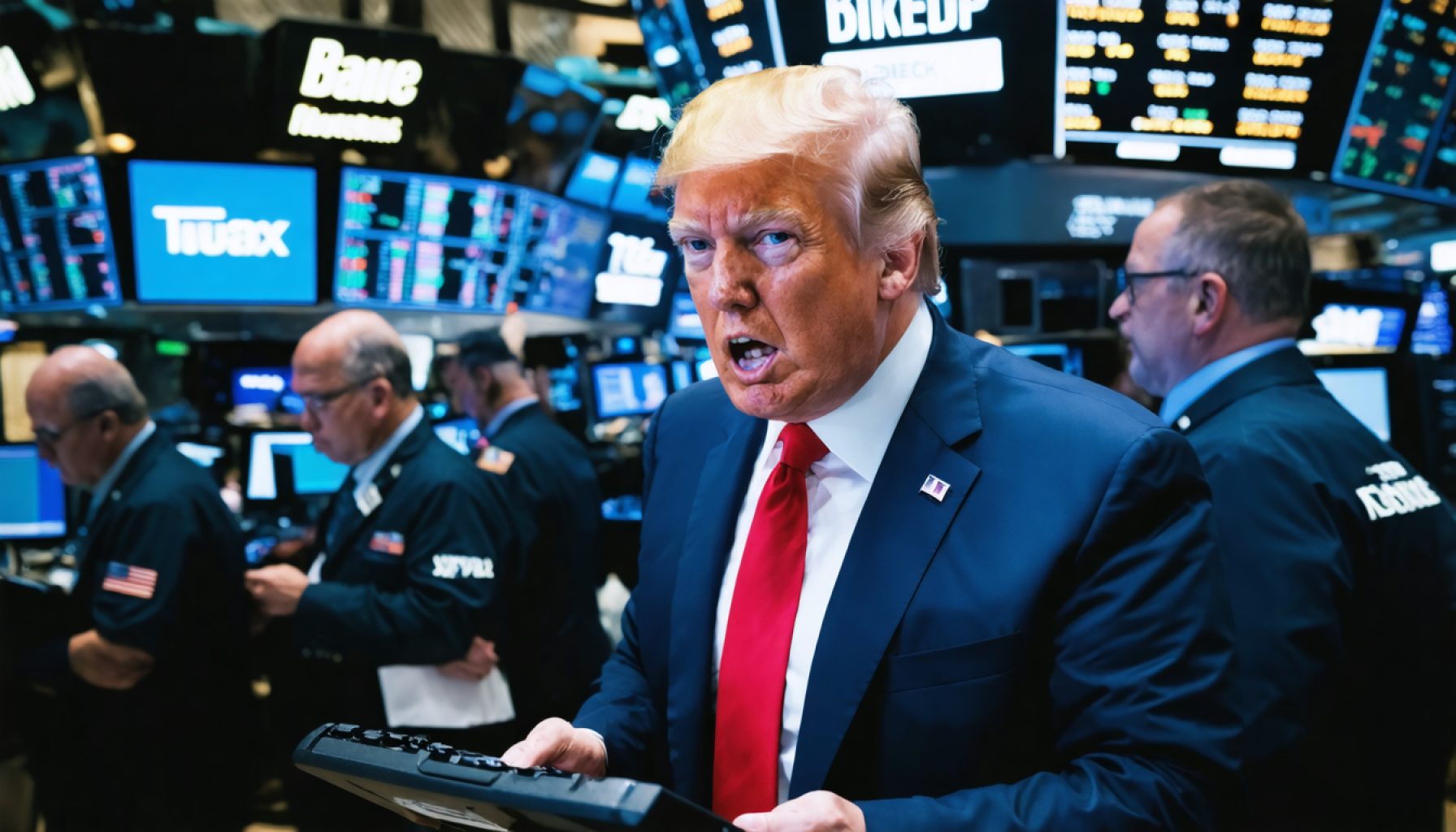
- Stock futures for the S&P 500, Nasdaq, and Dow Jones face a steep decline, foreshadowing a potential bear market driven by aggressive U.S. tariff plans.
- President Trump’s tariffs trigger global market turbulence, with a $5 trillion loss in market value, reminiscent of early pandemic drops.
- Global powers like China and the EU are countering U.S. tariffs, heightening fears of a trade war and economic slowdown.
- Despite recession concerns from major financial institutions, U.S. officials defend the tariffs, emphasizing potential trade renegotiations.
- Oil prices fall over 3% amid fears of weakened global demand due to trade conflicts.
- Market instability highlights the significant impact of geopolitical strategies on global economic conditions.
The air is thick with tension on Wall Street as it braces for another tumultuous Monday, with stock futures signaling a dramatic downturn. President Trump’s assertive tariff plans have sent shockwaves across global markets, unleashing a financial tempest that shows no signs of abating. The futures for the S&P 500, Nasdaq, and Dow Jones are plummeting by over 4%, highlighting a potential bear market for the Nasdaq and pushing the S&P 500 closer to that perilous territory.
As these market tremors unfold, the backdrop is a dramatic shift in trade policy. Trump’s imposition of broad tariffs on U.S. trading partners has already led to a staggering $5 trillion loss in market value, reminiscent of the darkest financial days at the pandemic’s onset. This audacious move has prompted swift counteractions from global powerhouses like China and the European Union, igniting fears of an all-out trade war that could stymie economic growth worldwide.
Even as Wall Street reels, the administration stands undeterred. Officials have publicly defended the tariffs, dismissing looming recession fears voiced by leading financial institutions like JPMorgan. The prospect of a global economic slowdown looms large, while economists rapidly revise growth projections in response to this seismic policy shift. Treasury Secretary Scott Bessent and economic adviser Kevin Hassett maintain optimism, pointing to a flurry of countries seeking trade renegotiations—with promises of logistical challenges looming on the horizon.
Despite the mounting criticism and financial fallout, President Trump remains a paragon of resilience. A series of social media posts paint him as unfazed, urging the American public to remain steadfast. Meanwhile, internal assessments downplay any intentions of undermining the stock market, framing these moves as a long-term strategy to uplift American industries and workers.
Adding to the turmoil, the oil market suffers as prices dive over 3%, further fueled by concerns of global demand weakening under the weight of an escalating trade conflict. As these events unfold, investors and consumers alike find themselves at the mercy of a rapidly changing economic landscape, where past assumptions are swiftly overturned.
Through this unfolding chaos, one lesson emerges with clarity: the interplay between global commerce and geopolitical strategies has profound impacts on market stability. As the world watches, there is much at stake—not only for financial markets but for the broader global economy. The need for careful navigation and nuanced policy-making has never been more apparent, as nations grapple with a new era of economic uncertainty.
Wall Street Turmoil: What You Need to Know About Global Trade Tensions
Unpacking the Market Turmoil: A Comprehensive Guide
The global financial market is amidst a dramatic upheaval, marked by widespread anxiety on Wall Street. Stock futures indicate a significant downturn, with the fear of a prolonged bear market looming large. This scenario unfolds against the backdrop of President Trump’s aggressive tariff plans, which have rattled global markets and sparked severe reactions from other economic powerhouses.
Key Elements Missing from the Initial Discussion
1. Historical Context and Impact:
– Trade Wars: Historically, aggressive tariff impositions have often led to trade wars, which tend to dampen economic activities. For instance, the Smoot-Hawley Tariff Act of 1930 was one of the factors that exacerbated the Great Depression by stifling international trade.
– Market Volatility: Similar market reactions were observed during the 2018 U.S.-China trade tensions, underscoring the sensitivity of global markets to geopolitical developments.
2. Future Economic Projections:
– IMF Projections: The International Monetary Fund often adjusts its global economic forecasts based on trade policies. A potential trade war could lead to a downgrade in global growth projections, pushing many economies to the brink of recession.
– Supply Chain Disruptions: Tariffs can lead to supply chain reconfigurations, with companies seeking to relocate manufacturing bases to avoid higher costs, as seen in the shifting of electronics and automobile manufacturing in recent years.
3. Market Forecast & Industry Trends:
– Technology and Innovation: With the tech-heavy Nasdaq under pressure, the future of tech innovation may face challenges if capital inflows decrease amidst prolonged market instability.
– Renewable Energies: The shock to oil prices should propel discussions on diversifying energy sources, potentially accelerating investments in renewables.
Addressing Common Reader Questions
What Are the Long-Term Effects of Tariffs on the Economy?
– Increased Prices: Tariffs often lead to higher costs for imported goods, which can reduce consumption.
– Production Costs: U.S. industries reliant on imported materials might face higher operational costs, leading to decreased competitiveness.
How Might This Affect Individual Investors?
– Short-term volatility could impact savings and retirement accounts, so diversification becomes key. Consider positioning a portfolio to withstand market fluctuations by including bonds and defensive stocks.
Actionable Recommendations
1. Diversify Investments: Invest in sectors less subjected to international trade tensions, such as utilities and healthcare.
2. Monitor Policy Changes: Stay informed about any new trade agreements or policies that could mitigate the impacts of tariffs.
3. Enhance Financial Literacy: Understanding economic indicators and market forces can help make more informed financial decisions.
Real-World Use Cases
– Companies Adjusting Strategies: Corporations like Apple have been realigning their supply chains out of China to mitigate tariff impacts. This exemplifies strategic pivots in response to policy shifts.
– Alternative Markets Exploration: Companies might explore emerging markets in Southeast Asia to offset losses due to higher tariffs from traditional trading partners.
Conclusion: Navigating Economic Uncertainty
As uncertainty grips global markets, proactive strategies are vital for investors and businesses alike. By diversifying, staying informed, and adapting to shifts, stakeholders can better navigate this complex landscape.
For broader insights on financial strategies in tumultuous times, visit Fidelity or Charles Schwab for more expert financial guidance.



